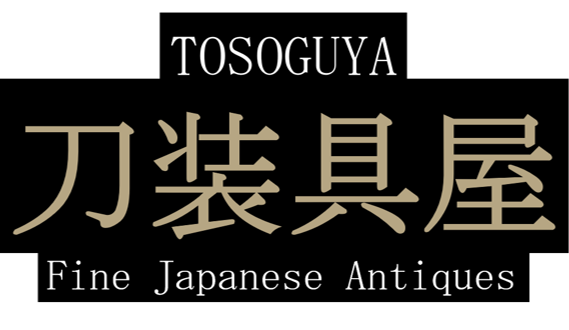

A dignified and excellent kōgai attributed to Gotō Kōjō (光乗) (1529 - 1621), the 4th mainline master of the Shirobei branch of the Gotō family of sword furniture makers. Kōjō is not as widely known as his famous father Jōshin, who died as a samurai in battle, or his legendary great grandfather Yujō, the first Gotō master who served the Ashikaga shōgun Yoshimasa. The works by Kōjō are relatively few when we consider he lived 92 years, though his technique is thought to be more detailed and evolved compared to the first 3 Gotō generations. Kōjō worked directly for both Oda Nobunaga and Toyotomi Hideyoshi, and was highly regarded by both of these titans of Japanese history. Nobunaga made Kōjō the head of the mint, and Hideyoshi permitted him continue in that post. His son, Tokujō (5th mainline master) dovetailed with his father, taking over the operatorship of the mint under the third great unifier of Japan, Tokugawa Ieyasu. The first 4 mainline masters never signed their works, so attribution is made through experience, and sometimes through attestation by later members of the Gotō lineage. In fact, Tokujō wrote numerous attestations for his predecessors work, and they were prized possessions, often gifted to deserving samurai by the Tokugawa and other daimyo.
The motif is of a crawling male dragon (這龍図). Kōjō and his son Tokujō introduced a wider palate of themes, metals and techniques to the Gotō repertoire. His father's work was more singular - recognizable single motifs, large, deeply carved and bold. Kōjō's work maintains the height and depth of carving, while moderating the size of objects and increasing the amount of detail and scope of composition. His work is transitional with that of his father, and then with his son, who further expanded the artistry of the metal work. He is also known to have produced works jointly with both father and son. For this reason, attributions directly to Kōjō are rarer, as it requires familiarity with nuances. As illustration of this, the kogai is published in the seminal reference book on the subject, Ko-Kōgai by Ikeda (see below). Ikeda attributed this kogai to Tokujō. Later however, the NBTHK attributed the kogai to Kōjō. Having handled a number of pieces of this same motif by both Jōshin and Tokujō, I would suggest that the carving style is closer in style to the former (masculine, bold, with considerable niku), but slightly more graceful and nuanced. The nanako is a little coarser than the style typical of the Muromachi, and the ji-ita exhibits a reasonable amount of wear, commensurate with considerable age. Overall, I believe this kogai reflects the mood and look of the late 16th century. I feel that the current attribution to Kōjō is appropriate.
The kogai is made of black shakudō (赤銅), with a very finely punched background of nanako (魚子地). Gold foil has been extensively applied to the entire kogai outside of the decorative plate (ji-ita). The dragon affixed to the plate is carved in solid gold. The fine nanako on the plate is a little worn down outside of the high relief motif. This is a normal characteristic of old kogai. The NBTHK Hozon papers use the terms kinmon ura-fukumi-kin, to describe the gold work. Kinmon refers to the dragon motif that is carved out of gold in katachibori technique (the subject is the outline of the carving), and inset into the shakudo nanako plate. Ura-fukumi-kin indicates that the entire backside (ura) of the kōgai has been enclosed / gilded in gold foil. The foil has been decorated with file marks, providing more texture and depth to the ornamentation.
I have been privileged to be able to offer in the last several months, kogai by 3 successive masters of the Gotō main line. For reference, see kogai by Kōjō's father Jōshin here, and grandfather Sōjō here. Take the time to compare and contrast the pieces, its educational.
Translation of the Hozon paper description follows:
這龍図笄 (Hairyū-zu
kōgai)
無銘 光乗 (Mumei Kōjō)
赤銅 魚子地 金紋
裏哺金 (Shakudō nanako-ji
kinmon ura-fukumi-kin)
Heisei 16th year (2004) February 24th
Ex-Ikeda Suematsu Collection
Published: Ko-Kōgai. Ikeda Suematsu and Miyake Teruyoshi. 1997. pg. 23
Measurements: 21.16cm x 1.23cm x 0.66cm
Azuchi Momoyama Period (安土桃山時代), late 16th century
SOLD

